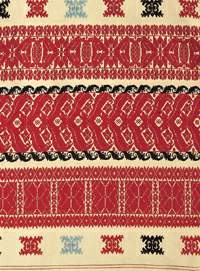Juraj Zajonc
Even though it is not known when weaving appeared in textile techniques, it is probably the youngest method of creating textiles. Its technological principle has not changed from the Neolithic Age, where the first traces of the existence of weaving date from. However, the tools and machines used for splitting fibres and creating the variety of connections for passing the weft or weaving patterned textile have undergone major changes. Excavations of earth weights from vertical weaving machines and prints of woven structures on ceramics dating from the Neolithic Age confirm the continuity of textile production on the territory of Slovakia. The traditional production of fabric where the base was flax, hemp or sheep’s wool was, in comparison to several other areas of processing raw products, for a long time only in-home production closely connected to agriculture. It started to separate more significantly only in the 12th – 13th Century. Individual weaving guilds started to appear in towns in the New Ages, and they were relatively rare because fabric weaving was still carried out at home. Manufacturers played an important part in the production of fabric in Slovakia. Despite the development of the manufacturing and industrial production of fabrics, the domestic production of decorated or non-decorated fabrics in the villages of central, eastern and partially the western part of Slovakia held a significant position until the 20th Century. Although the old technological processes, decorative elements and principles, and natural materials were preserved in the home production of fabric, domestic weavers also explored the creation of new patterned fabric without technological or aesthetic barriers.
